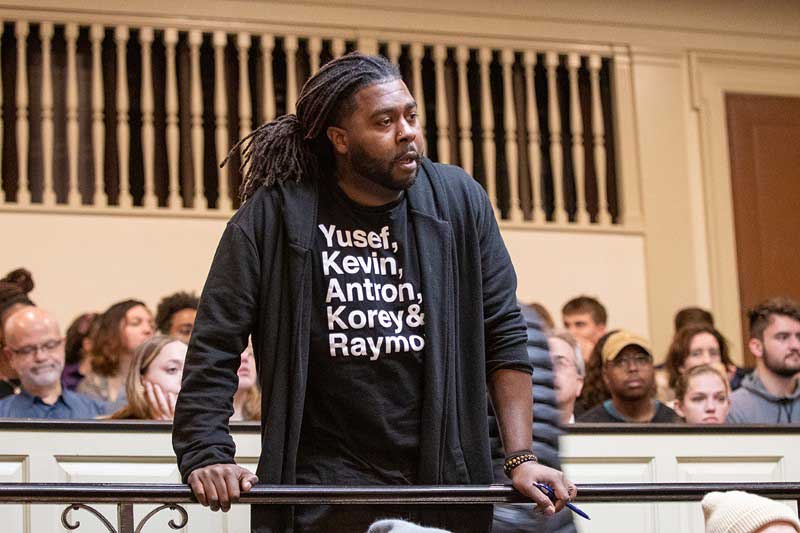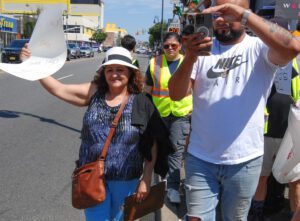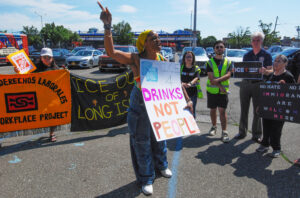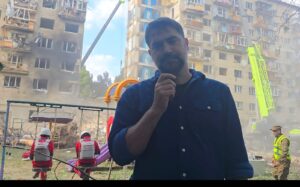By Amber Clavette, Ruth Sobey, Emily Suter and Diana Reigel
Starting last summer, the social media movement #BlackintheIvory gained attention and created a space for faculty and students to tell their stories about the racism that they have experienced in academia.
Kristal Brent Zook, Ph.D., a journalism professor in the Lawrence Herbert School of Communication at Hofstra University, expanded on this hashtag movement in her January New Yorker article, “How Black Lives Matter Came to the Academy.”
The strong reaction to the article prompted Zook to host a Zoom panel discussion on the subject March 11 at Hofstra, touching on similar points discussed in her New Yorker piece with four panelists.
Zook, who acted as moderator, has published work on race, social justice, women and culture in dozens of magazines, newspapers and digital outlets. She was joined by:
- Veronica Lippencott, Ph.D., adjunct associate professor of global studies and geography at Hofstra.
- Tomeka Robinson, Ph.D., professor of rhetoric and public advocacy, and the forensics director in the Department of Writing Studies and Rhetoric, at Hofstra.
- Alexander Pineda, a CNN producer and 2015 Hofstra graduate.
- Biko Mandela Gray, Ph.D., assistant professor of religion at Syracuse University.
Panelists shared their experiences with and feelings about systemic racism in academia, as well as how they are raising awareness of the issue.
Lippencott, who directs the African Studies program and is the associate director of the Center of “Race,” Culture and Social Justice at Hofstra, started the conversation with, “It’s really a great historical moment that we live in an era where we have these social media spaces to discuss our collective experiences as Black people here in the U.S., and so for me Black in the Ivory represents pain and promise.”
Lippencott expanded on this idea by sharing her family’s story with the audience, how they worked hard and still struggled, including her father, who completed two master’s degrees but ended up managing a 7-Eleven. As a geographer, Lippencott said, she attended graduate school as the only Black person in her department and worked in a predominantly white space. Stories like hers, she said, represent pain and promise, because the reality of it is that systemic racism has affected many students and still does to this day, but there is the promise that systems can change if educators and students share their stories and raise awareness.
Robinson shared a similar experience. She was an undergraduate student at a primarily white institution and was told by a department chairperson that “women of color don’t succeed in the science field.”
The comment only motivated Robinson to prove the naysayers wrong. She did exactly that and completed her degree. She shared more of her experiences with systemic racism in graduate school, including an instance in which a professor said people of color, particularly women of color, couldn’t write. Now she is raising awareness and effecting change by delivering lectures to students at Hofstra, explaining what the Black Lives Matter Movement is and why it matters to engage students in conservations.
“It’s not just trendy to have the counter slogan ‘All lives matter,’” Robinson said, “but that’s actually a form of racialized abuse against people. I really want to raise the awareness, as well as help people understand how this counter phrase, and going back and forth is completely de-racializing an entire movement, and it’s extremely problematic.”

Mandela Gray asked, “What does it mean for us to be Black in a space that is explicitly ivory in nature?” If Black students are consistently shut down or disregarded when speaking up about systemic racism in schools, how can injustice be fixed?
Pineda discussed a different perspective that he had growing up in a predominantly white area of upstate New York and how that impacted his sense of the world. “I’m sure that the way that I grew up has really played a role in my ability to flourish in predominantly white spaces,” he said.
He also shared that his experiences with white people have helped him succeed in his professional life, but this is not the case for every Black person. “We don’t want wasted potential,” he said. “We don’t want kids to fail out and not be successful later in life once they get into the real world because they were not able to flex those muscles and build those relationships.”
When the panelists opened the floor for audience questions, a Hofstra student came forth with her own experiences of systemic racism in college. She said she was a victim of racism, targeted by public safety officers who searched her dorm room and rummaged through her belongings. A philosophy professor also gave her a failing grade without, she said, good reason, to which she had to appeal, and even then she did not receive the grade that she thought she deserved. Now she takes independent courses and teaches herself because she feels like a victim of systemic racism.
Erasing structural racism means “radically restructuring universities,” the panelists agreed. Those in academics need to be honest about what is happening and acknowledge the injustice that African-Americans and other people of color face at colleges and universities. It is important for everyone to feel safe and valued at their university, according to the panelists.
Tweets and hashtags, they said, can push the issue and convey the inclusivity message.








